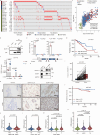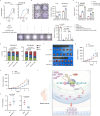DCAF13-mediated K63-linked ubiquitination of RNA polymerase I promotes uncontrolled proliferation in Breast Cancer
- PMID: 39788980
- PMCID: PMC11718263
- DOI: 10.1038/s41467-025-55851-9
DCAF13-mediated K63-linked ubiquitination of RNA polymerase I promotes uncontrolled proliferation in Breast Cancer
Abstract
Hyperactivation of ribosome biogenesis (RiBi) drives cancer progression, yet the role of RiBi-associated proteins (RiBPs) in breast cancer (BC) is underexplored. In this study, we perform a comprehensive multi-omics analysis and reveal that assembly and maturation factors (AMFs), a subclass of RiBPs, are upregulated at both RNA and protein levels in BC, correlating with poor patient outcomes. In contrast, ribosomal proteins (RPs) do not show systematic upregulation across various cancers, including BC. We further demonstrate that the oncogenic activation of a top AMF candidate in BC, DCAF13, enhances Pol I transcription and promotes proliferation in BC cells both in vitro and in vivo. Mechanistically, DCAF13 promotes Pol I transcription activity by facilitating the K63-linked ubiquitination of RPA194. This process stimulates global protein synthesis and cell growth. Our findings uncover a modification of RPA194 that regulates Pol I activity; this modification is dysregulated in BC, contributing to cancer progression.
© 2025. The Author(s).
Conflict of interest statement
Competing interests: The authors declare no competing interests.
Figures








Similar articles
-
Loss of TRIM31 promotes breast cancer progression through regulating K48- and K63-linked ubiquitination of p53.Cell Death Dis. 2021 Oct 14;12(10):945. doi: 10.1038/s41419-021-04208-3. Cell Death Dis. 2021. PMID: 34650049 Free PMC article.
-
DCAF13 promotes ovarian cancer progression by activating FRAS1-mediated FAK signaling pathway.Cell Mol Life Sci. 2024 Oct 5;81(1):421. doi: 10.1007/s00018-024-05446-2. Cell Mol Life Sci. 2024. PMID: 39367995 Free PMC article.
-
Overexpression of ARHGAP30 suppresses growth of cervical cancer cells by downregulating ribosome biogenesis.Cancer Sci. 2021 Nov;112(11):4515-4525. doi: 10.1111/cas.15130. Epub 2021 Sep 21. Cancer Sci. 2021. PMID: 34490691 Free PMC article.
-
Dysregulated Ribosome Biogenesis Reveals Therapeutic Liabilities in Cancer.Trends Cancer. 2021 Jan;7(1):57-76. doi: 10.1016/j.trecan.2020.08.003. Epub 2020 Sep 15. Trends Cancer. 2021. PMID: 32948502 Review.
-
Coordinated Control of rRNA Processing by RNA Polymerase I.Trends Genet. 2019 Oct;35(10):724-733. doi: 10.1016/j.tig.2019.07.002. Epub 2019 Jul 26. Trends Genet. 2019. PMID: 31358304 Free PMC article. Review.
References
-
- Yang, X. M. et al. Nucleolar HEAT repeat containing 1 up-regulated by the mechanistic target of rapamycin complex 1 signaling promotes hepatocellular carcinoma growth by dominating ribosome biogenesis and proteome homeostasis. Gastroenterology165, 629–646 (2023). - PubMed
MeSH terms
Substances
Grants and funding
- 82073067/National Natural Science Foundation of China (National Science Foundation of China)
- 81872140/National Natural Science Foundation of China (National Science Foundation of China)
- 2022B1515020100/Guangdong Science and Technology Department (Science and Technology Department, Guangdong Province)
- 2019B020226003/Guangdong Science and Technology Department (Science and Technology Department, Guangdong Province)
- 2023B1212060013/Guangdong Science and Technology Department (Science and Technology Department, Guangdong Province)
LinkOut - more resources
Full Text Sources
Medical

